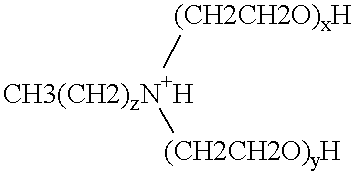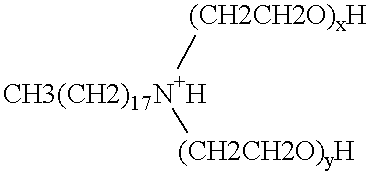Polymerase stabilization by polyethoxylated amine surfactants
a technology of amine surfactants and polyethoxylated amines, which is applied in the direction of enzyme stabilization, enzymology, transferases, etc., can solve the problems of loss of activity and insufficient c12 chain length for cooperative binding
- Summary
- Abstract
- Description
- Claims
- Application Information
AI Technical Summary
Benefits of technology
Problems solved by technology
Method used
Image
Examples
example 2
Screening of Surfactants
In this example, surfactants were screened for their ability to stabilize enzymes. The following compounds were dissolved in nanopure water to a final concentration of 10% (either w / v or v / v depending if the material was a solid or liquid, respectively): Tetradecyl-trimethyl-ammonium bromide (Sigma T4762), Dioctyl sulfosuccinate (Sigma D-4422), Cholic Acid (Sigma C-1254 lot 56H0339), Taurocholic Acid (Sigma T-4009, lot 15H5001), Chaps (Sigma C-3023, lot 86H5022), Chapso (Sigma C-3649, lot 35H5065), Cetylpyridinium chloride (Sigma C-9002, lot 77H1047), Tween 20 (Sigma P-1379) and TRITON X-100.
A 10.times. buffer was made with each of these surfactant solutions. The 10.times. buffer for each consisted of: 500 mM KCl, 100 mM Tris-HCl pH 9.0 (at 25.degree. C.), 1% surfactant (made by a 1:10 dilution of the detergent solution described above into the buffer during formulation). As described in Example 1, the Taq polymerase used in these experiments was purified wit...
example 3
Screening of Additional Surfactants
In this example, additional surfactants were screened for the ability to stabilize proteins. Solutions (10% w / v or v / v) of the following materials were made in nanopure water: N-dodecyl-n,n'-dimethyl -3-ammonio-1-propanesulfonate (Sigma D-4516, lot 95H5045), Mega 10 (Sigma D-6277, lot 37H5041), N-octadecyl-N,N-dimethyl-3-ammionio-1-propane-sulfonate (Sigma O-8004, lot 44H5006), SB 3-10, N-Tetradecyl-N,N-dimethyl-3 Ammonio-1-propanesulfonate (Sigma T-7763, lot 96H5001), Dimethyl dioctadecyl Ammonium bromide, TRITON X-200 (Sigma X200, lot 75H0989), TRITON W-30 (Sigma Chem Co., W-30, lot 18F0766), TRITON X-301 (Sigma X301, lot 13H7706), TRITON 770 (Sigma 770, lot 18F0768).
Ninety-nine microliter aliquots of the master reaction mix described in Example 1 were placed into separate 0.2 ml tubes, then 1 .mu.l of the 10% surfactant solutions and 2 .mu.l of Taq polymerase (10 U / .mu.l) purified in the absence of detergent were added to each tube. Control reac...
example 4
Screening of Additional Surfactants
In this example, additional surfactants were screened for the ability to stabilize proteins. Solutions (10% w / v or v / v) of the following materials were made in nanopure water: Miracare ZMHT, Miracare ZMCA, Mirataine BB, Mirataine ACS, Mirataine CBR, and Mirataine CB (Rhone-Poulenc, North American Chemicals, Cranbury, N.J.). The surfactant solutions were tested at the 0.1% level as described in Example 3 by comparison with Tween 20 and no surfactant control reactions, except that the enzyme concentration was lowered to 10 U of Taq per 100 .mu.l reaction mix.
A strong 1.5 kb DNA band was seen in the Tween 20-supplemented reaction and no band was seen in the reaction without added surfactant. All of the other reactions failed to produce a visible 1.5 kb DNA fragment. These results indicate that none of these surfactants is equivalent to Tween 20 as a stabilizing agent for Taq polymerase.
PUM
| Property | Measurement | Unit |
|---|---|---|
| Fraction | aaaaa | aaaaa |
| Molar density | aaaaa | aaaaa |
| Molar density | aaaaa | aaaaa |
Abstract
Description
Claims
Application Information
 Login to View More
Login to View More - R&D
- Intellectual Property
- Life Sciences
- Materials
- Tech Scout
- Unparalleled Data Quality
- Higher Quality Content
- 60% Fewer Hallucinations
Browse by: Latest US Patents, China's latest patents, Technical Efficacy Thesaurus, Application Domain, Technology Topic, Popular Technical Reports.
© 2025 PatSnap. All rights reserved.Legal|Privacy policy|Modern Slavery Act Transparency Statement|Sitemap|About US| Contact US: help@patsnap.com



